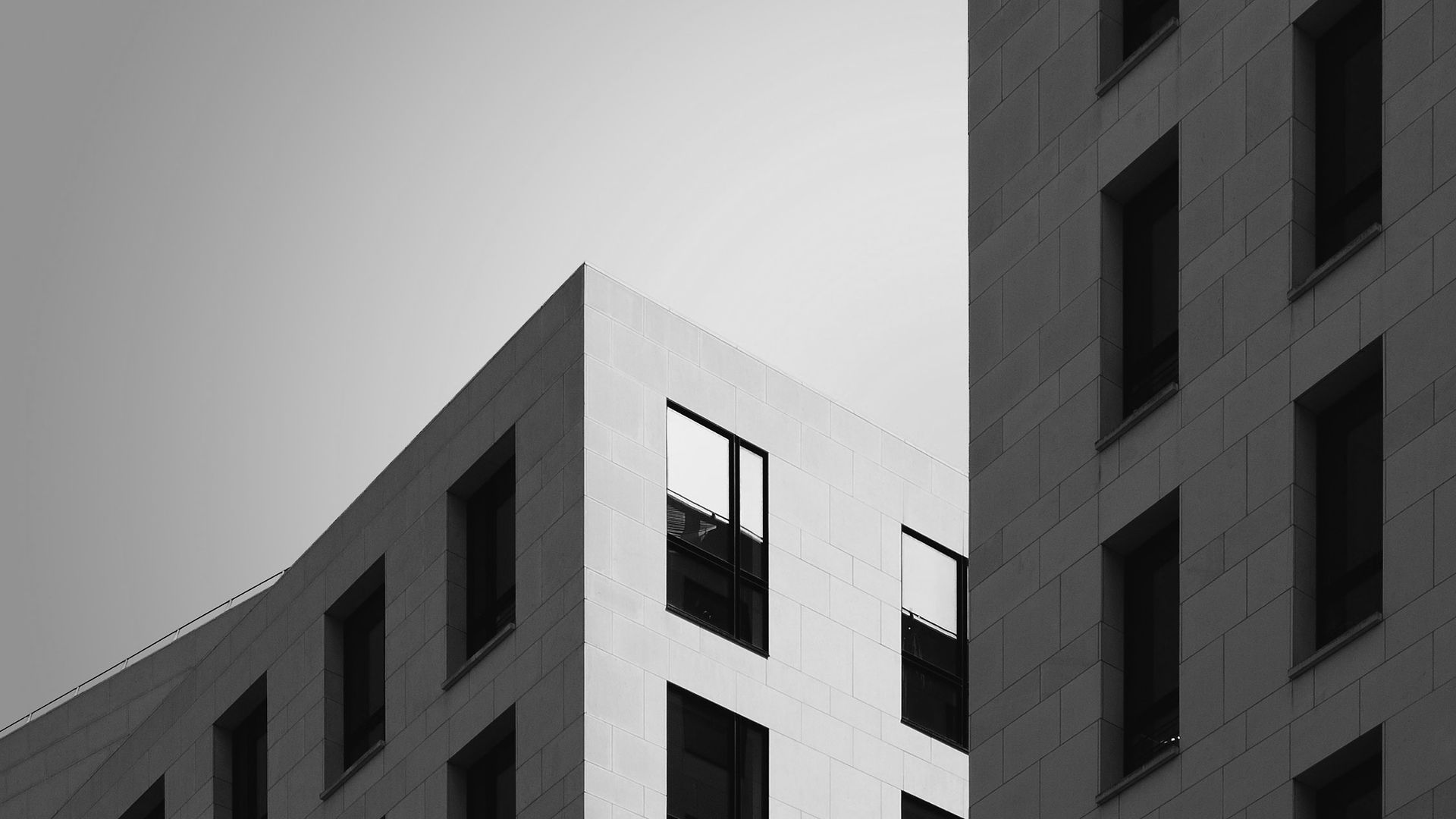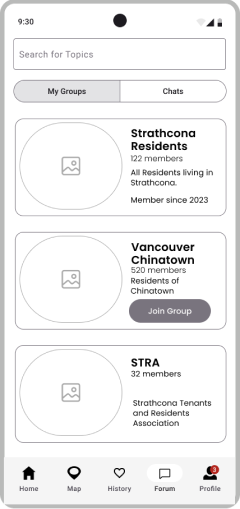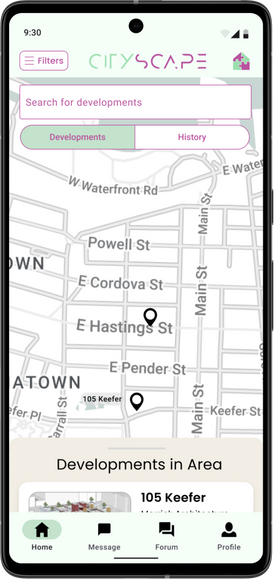
Cityscape
An app designed to empower local residents to build community ownership by engaging with upcoming developments in their neighborhood. Cityscape allows them to view historical projects and their impacts, discuss problems with their neighbors and directly submit feedback to the city.
Role:
Duration:
Tools:
Client
Lead UX Designer
10 weeks
Figma, Adobe AI, PS
CAAD Design Group

So... what's happening?
Cities around the world are vying for the title of “the most liveable city in the world”. However, a question should also be posed: “At what cost?” Minorities and low income residents have often been displaced and their perspectives and voices erased as urban renewal takes root.
Some US Cities are losing over 75% of their minority residents even as populations grew by 10%.
-NCRC
Gentrification and displacement of low income residents in the Downtown Eastside forces 15-20% of the community to leave every year
- Atira Womens' Resource Society
Problem
Low - Mid income residents are being displaced and priced out as neighborhoods gentrify. Further, they often feel helpless and voiceless as new developments proposed encroach within their neighborhoods.
Solution
Using the diverge-and-converge technique in UX, I conducted thorough research and synthesis on the gentrification experience. With these findings, I finalized my solution with a hi-fidelity app design that aims to provide job candidates consistent communication throughout the hiring process.
Step 5
Test
Step 1
Empathize
Step 2
Define
Step 3
Ideate
Step 4
Refine
Extended context
Contemporary planning policies favor development, often displacing minorities, and lead to gentrification and displacement under the guise of urban renewal. As development happens within a neighborhood, housing costs and rents increase along with the construction of new amenities, attracting more affluent and higher income residents. As a result, lower income residents and minorities are disproportionally affected as the cost of living forces them to move to less ideal locations, often within the suburbs.
According the NCRC, this racial, income, and ethnic displacement have occurred in over twenty cities across the United states since 2013.
With Vancouver in context, a survey showed that over 90% of residents are unaware of Hogan’s Alley, a historic black community that was demolished for project in the name of urban renewal. In this particular case, around 800 residents were displaced with some moving to the suburbs, relocating to other Canadian cities or even returning to the US. (2, 3)
Today, the displacement and erasure is happening again with low income residents in the Downtown Eastside. Within the DTES, there are approximately 1548 residents whom are considered unhoused. Further contributing to the problem, a report by the Carnegie Community Action Project estimated that around 15-20% of the low income community are displaced each year due to gentrification, evictions, and rent increases as the neighborhood develops.
Lower income residents and minorities are disproportionately affected by the increases in cost of living caused by gentrification leading to displacement.
15-20% of the low income community are displaced each year due to gentrification, evictions, and rent increases in Vancouver's Downtown east side.
So what can we do?
It's unfortunately unrealistic to overhaul entire systems of city planning to ensure that developments are equitable and just, to help slow gentrification and displacement. There are simply too many variables including differences in city policies across the US & Canada, bureaucracy, and access.
However what if I could find a way to empower residents by helping them build a sense of community ownership to make their voices heard?
With that in mind, I conducted a series of interviews to learn more.
Interviewing residents in gentrifying neighbourhoods across the US and Canada
"If prices keep rising, I would have to leave. I wish there was a way for local residents to be more unified and have a unified voice to be able to speak their concerns"
I talked to five low-mid income minority residents in five different cities facing gentrification across the US and Canada, all of whom have faced pressures from forces of gentrification in their respective cities.
A key sentiment started to emerge as a common pain point. Residents don't know what they can do to help ensure their security of staying within their neighborhoods as new developments occur and along with it, rising costs of living.
Pain points
Motivations
Behaviors
Loss of culture and identity due to displacement and gentrification.
Lack of belonging and community following new developments completion
Unsure of what can be done to ensure our community's voice is heard.
Unsure about how historical developments have impacted communities and how to learn from them.
Have a voice in community engagement to have a say in our future community.
Ensure that all residents in the neighbourhood are represented and have their voices heard.
Preserve the culture and heritage of the neighborhood as it changes.
Continue living in a neighborhood that is diverse and vibrant.
Seeking information and education on gentrification and its impacts on communities over time.
Values public community engagement on projects that will affect the neighborhood,
"How might we empower residents to engage with the issues caused by gentrification so that they can build community ownership with a unified voice and avoid displacement by future developments."
This is Angela Razon. She may not be real, but she is the persona, representing residents to my solution


So...how can a potential app help empower residents?
The key is to think like minority residents in neighborhoods facing gentrification without forgetting other stakeholders as well.
I want my solution to be practical. Right now, it is exhausting for residents to find information on developments. The only real way is to search up development codes on city websites and even then, it is a tangled web of terminology that only designers and planners know.
Simultaneously it is also exhausting for cities to engage residents with the only way being scheduled development meetings which often fail to truly engage all members of a neighborhood.
Core Epic: Build community ownership to empower residents
As a resident of a gentrifying neighborhood,
I want to:
So that...
share and promote the unique culture and history of my neighbourhood,
I can educate others and raise awareness and appreciation of its value.
connect with other residents who share my concerns and values
we can build a sense of communal ownership and advocate for our rights and interests.
support and advocate for the vulnerable and marginalized groups in my neighbourhood
I can help them cope with the displacement and discrimination they may face.
be updated on upcoming developments and projects
I can research how they might affect me and my neighbors.
share my concerns with neighbours about potential upcomign projects
my neighbors and I can discuss and act on our concerns.
collaborate with my neighbours to learn history
we can learn from past movement on how to tackle gentrification
to paticipate in local planning and development processes with my neighbours
I can influence the outcomes and ensure that they reflect the needs of the existing community by making our voices heard

How does this task flow help?
The user task flow helps residents in a neighborhood facing gentrification by allowing them to monitor and respond to the changes that affect their lives and culture.
By helping show developments of concern in a neighborhood, the user task flow enables residents to identify and report issues such as rising rents, eviction notices, demolition plans, or loss of community services.
Showing historical precedents, provides residents with information and examples of how other neighborhoods have dealt with similar challenges and what strategies have worked or failed.
With a forum, the task flow fosters communication and collaboration among residents, as well as with other stakeholders such as local activists, organizations, or officials.
Finally, by providing direct feedback to the city, the user task flow empowers residents to voice their opinions and demands, and to influence the policies and decisions that affect their neighborhood.
This task flow thus helps residents in a neighborhood facing gentrification to preserve their history and culture, to protect their rights and interests, and to participate in shaping their future.
With that in mind, I starte creating a series of sketches which can help residents do exactly that.
protect
heritage

collaborate
engage


Schematic Design - Exploratory sketching
Having analyzed the needs of our persona, Angela through user stories and creating a task flow, I created a set of preliminary schematic design sketches in low fidelity to start bringing these tasks and potential features to life.



Hero Page
Developments List
Developments Details
Forum
Groups
Posts within
Forum
Iterate. Iterate. Iterate.
The first iteration is definitely not always the best solution. Moving from sketches to mid-fidelity wireframes, I tested a prototype with ten users to observe how they interacted with the application over two rounds of user testing. This helped me identify a few major useabiliy issues within the hero page and developments pages.
1. Lack of Familiarity in regards to Planning and Zoning Terminology:
Some of the Terminology used was confusing to testers whom were not familiar with planning and architecture. This was an easy fix and hence implemented in the low-fidelity wireframes.
2. Clumsy User Flow in between Hero page and getting to developments info:
As part of the tasks and scenarios provided, testers were asked to find information on a specific development within their neighbourhood. While all users were able to successfully find the development. many also took a long time to find the right flow. This made me realize that there were simply too many taps to get to the development information page, providing me the feedback I needed to iterate and simplify the application for high fidelity later on.

Version 1
Version 1 shows the details of the development including a contrast between existing and proposed constructions. However, users were confused about the terminology used.


Version 2
Version 2 adds frames to allow the statistics to be easier to read and also adds a pop-up modal to break down definitions of planning and zoning terms
What does Cityscape represent?
City
Definition:
an inhabited place of greater size, population, or importance than a town or village.
Scape
Definition:
a view or picture of a scene
or
to shape and form
Cityscape
Definition:
a view of the city
and
the shaping of a city
and
the formation of a space
Cityscape embodies empowerement. Allowing residents to landscape and create a city that works for them as new developments are proposed through engagement and learning of impacts from past developments. Likewise, it connects the city with residents, allowing city planners and developers to more meaningfully respond to resident feedback and create more inclusive and diverse developments that work for all residents. As such we formed a visual identity embodying these connections.
Cityscape's Identity
Empowering, Community Focused, Welcoming
We want users to feel welcomed to Cityscape when using the app. Every member of the community from planners to architects to especially, everyday residents. We want to make sure that the app empowers all to collaborate and meaningfully engage in a comfortable and welcoming environment and hence we chose our fonts and colours with that intent in mind

#C3E3CC
#B9529F
#333333
#F2EEE5
#353535

Introducing Cityscape
Combining insights research and creating a full branding package, were proud to present Cityscape! Cityscape builds a sense of community ownership among community members and empower them to meaningfully engage with developments within their neighborhood while simultaneously allowing city planners to get meaningful community engagement!

A solution that benefits all residents of a city.
Learn about developments in your neighborhood.
Residents are empowered by keeping up to date on new developments in their area which will affect them to stay informed.
Learn about historical redevelopments and their impacts on neighborhoods.
Users can take lessons learnt from historic built projects and their impacts since to hypothesize how future developments may affect them.
Engage residents in community forums
Residents can engage neighbors in discussion on upcoming projects which may affect their neighborhood to gain community feedback and input.
Provide feedback to the City
Residents can directly engage city planners to provide feedback. Planners can then meaningfully conduct community engagement
Introducing Cityscape on Desktop
Cityscape on desktop also allows residents ease in exploring and discovering new developments in their neighborhood from a desktop environment.

Home Page

Development Details
Cityscape is an app that helps residents take charge of their neighborhoods future!
With Cityscape, city residents can:
-
Build community ownership by connecting with your neighbors and sharing your stories, values, and goals.
-
Find information on upcoming developments and how they will affect your neighborhood’s character, affordability, and livability.
-
Look at historical impacts of redevelopments and learn from the successes and failures of other communities facing similar challenges.
-
Discuss in forums and exchange ideas, opinions, and experiences with other residents and stakeholders.
-
Provide feedback to the city and make your voice heard on the issues that matter to you.
Cityscape is more than just an app.
It is a platform creating civic engagement and empowering social change.
What ifs ?
What if bad actors do with Cityscape?
On a low stakes note, bad actors could at worst spam the forums or send spam messages to city planners. This however can easily be resolved through verifications of phone and email.
A bigger problem however could be undue influence within the application by lobbyists and developers with other agendas which may taint the neutral state of Cityscape.
What if not enough users stay active on the application?
Cityscape would need to find more ways to continually engage with users and residents as community is ultimately the key to Cityscape's success as a community- building application.
What's next for Cityscape?
AR Implementation
We want to re-visualize the scenes and culture erased by gentrification. This is key because a primary way for users to gain a sense of communal ownership is to know and be able to engage with their culture and heritage.
With Vancouver in context, we plan on collaborating with the Collective Art, Architecture, + Design Group to create a series of AR time trace drawings. This would allow residents and visitors to walk through certain spaces across different eras of time to learn and see how the neighborhoods have evolved and changed over time as neighbourhoods gentrify and change.
































